Click on images to enlarge
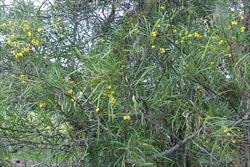
habit (Photo: Sheldon Navie)

smooth greyish-brown bark on younger trunk (Photo: Sheldon Navie)

reddish-coloured branches (Photo: Sheldon Navie)
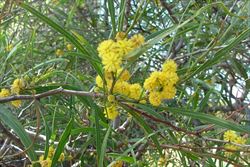
small yellow flower clusters (Photo: Sheldon Navie)
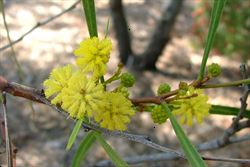
close-up of globular flower clusters (Photo: Sheldon Navie)

immature fruit (Photo: Rob and Fiona Richardson)
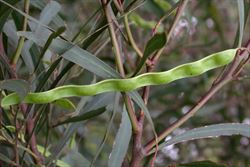
close-up of immature fruit (Photo: Rob and Fiona Richardson)
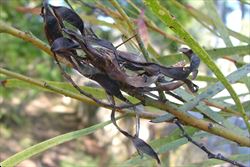
old fruit (Photo: Sheldon Navie)
Scientific Name
Acacia retinodes Schltdl. var. retinodes
Synonyms
Acacia floribunda hort. ex G. NicholsonAcacia fragrans hort. ex PottierAcacia longissima hort. ex ChopinetAcacia provincialis A. CamusAcacia retinodes Schltdl. var. floribunda H. Vilm.Acacia rhetinodes J.M. Black, orth. var.Acacia semperflorens hort. ex A. BergerRacosperma retinodes (Schltdl.) PedleyRacosperma retinodes (Schltdl.) Pedley var. retinodes
Family
Fabaceae: sub-family Mimosoideae (New South Wales)Leguminosae (South Australia)Mimosaceae (Queensland, the ACT, Victoria, Tasmania, Western Australia and the Northern Territory)
Common Names
everblooming acacia, ever-blooming wattle, silver wattle, swamp silver wattle, swamp wattle, water wattle, wirilda, wirilda wattle
Origin
Native to some parts of southern Australia (i.e. south-eastern South Australia and western Victoria). It occurs naturally on Kangaroo Island and in the Mount Lofty Ranges in South Australia, and from the Glenelg River to near Melbourne in Victoria.
Note: two distinct forms of this plant have been recognised, based on differences in morphology and the habitats in which they tend to grow. The first of these, which is known as the "typical variant" or "hill variant", is naturally restricted to the Mount Lofty Ranges region in South Australia, where it extends from Mount Bryan south through the Barossa Valley and the Adelaide Hills to Delamere on the Fleurieu Peninsula. This variant grows in fertile soils and on rocky hillsides away from water. The second variant, which is called the "swamp variant", is found over the entire range of wirilda wattle (Acacia retinodes var. retinodes), but generally grows in damp soils in swamps and along watercourses.
Naturalised Distribution
Naturalised beyond its native range in Victoria and the "typical variant" is naturalised beyond its native range in some parts of south-eastern South Australia.
Also naturalised overseas in parts of southern USA (i.e. California and Florida).
Notes
Wirilda wattle (Acacia retinodes var. retinodes) is regarded as an environmental weed in Victoria and is considered to pose a serious threat to one or more vegetation formations in this state. It appears on several local and regional environmental weed lists (e.g. in Knox City, Hume City, Mornington Peninsula Shire and the Goulburn Broken Catchment) and has been recorded in conservation areas (e.g. Yarra Bend Park in suburban Melbourne). It is probably of most concern on the Mornington Peninsula.
While wirilda wattle (Acacia retinodes var. retinodes) is native to some parts of Victoria, non-local forms from South Australia (i.e. probably the "typical" variant) are weedy and are considered to be environmental weeds. Such forms are not recommended for planting near areas of conservation significance in Hume City Council. It has also been suggested that local forms of this species may become weedy in bushland areas if they are managed incorrectly (i.e. the frequency of fires is reduced). However, this may once again be because non-local forms are causing the problems.
The "typical" variant of wirilda wattle (Acacia retinodes var. retinodes) has also become locally naturalised outisde its native range near Mount Gambier in south-eastern South Australia, where it has spread from deliberate plantings to form small colonies.

